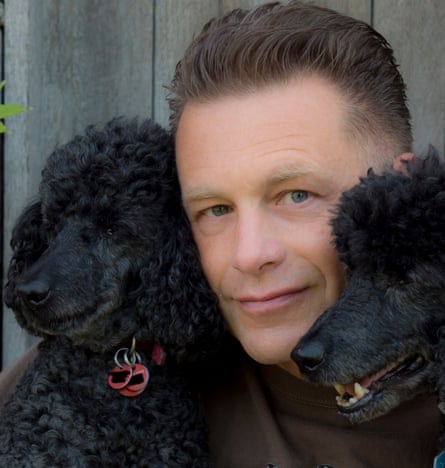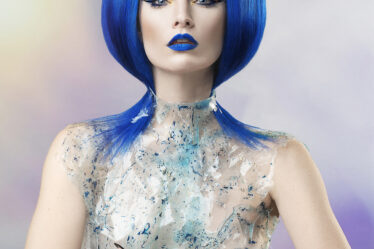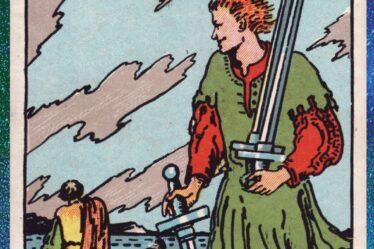
The first black miniature poodle in my life was Maximilian de Bastardos, Emperor of Midanbury. His overblown name was a reflection of his character. When he first came to us, he was merely Max, but he developed such a sense of self-importance that we found we needed to exaggerate it in his nomenclature.
What I learned from my 15-year relationship with Max is that poodles have strong personalities. They are characterful, smart, loyal and like naughty children – they constantly test you.
I got Itchy and Scratchy in 2014. We were like a triumvirate organism, linked in a triad. Later, when I met my partner, Charlotte, she fell in love with them, and vice versa, but they were always utterly devoted to me. Poodles are a bit like that.
For the first few years of their lives, I lived alone with them. For a lot of that time, I was living in France, completely by myself, so we had a very strong bond. It would often get bitterly cold, so they would want to sleep in the bed with me; we would get in this big pile of human and dog to stay warm. I would have restless nights because I was worried about them suffocating.
There were occasions when they had eaten something unpleasant and I would roll over in the night and get a face full of dog vomit. But, for biologists like me, that is not a problem. I don’t get het up about those sort of things.
I called them my joy grenades, because whenever I took them out and let them off the lead, they would run for the sheer joy of running. No matter how dark and dismal my mood might be, they would instigate instant euphoria. They could just lift me up; the joy that we shared was unparalleled.
We moved to the middle of the woods in the New Forest, where you could go out and never see anyone else. It was a utopian, sylvan landscape. I was a bit reclusive, but thankfully they got a chance to socialise with other dogs and people when they were with their dog sitter.
I remember taking them to Maiden Castle in Dorset on one particularly wild, windy winter’s day. Wind whips a poodle into a frenzy and rain really gets them going. They just ran that day. The sun was shining, but it was horizontal rain – and we were at this fabulous old hill fort. That was one of the greatest mornings of my life, being with them as they gyrated like electrons around an atom at hyperspeed. It was beautiful.
We had our language. A lot of people will understand the different barks of a dog; Itchy and Scratchy had about eight or 10 acoustic communications. The other thing they would do was sing. One of the tunes that would always set them off was Pure by the Lightning Seeds, one of my favourite pop songs. Whenever it came on, they would start howling.
Itchy became ill with cancer at 13 and we nursed him. We didn’t give him chemo – it was about the quality of his life, not the quantity. One of the best ways of expressing your love for an animal is choosing when to end its life. It’s hard, but you have to do it right. In the latter stages, Itchy was allowed to eat Maltesers.
We were conscious of the fact that we had to go through the process of leading Itchy towards his death, then immediately switch our attention to Scratchy, to make sure that he got through the separation. It was desperately tragic, because we would go to the woods and he would wait for his brother, looking over his shoulder. It took him quite some time to give up wondering where Itchy was.
Scratchy went on for another three years. He had a cataract operation, which transformed the end of his life, but it precipitated other underlying problems. He went into decline and we made the decision to have him euthanised. But he could see for the end of his life, which was marvellous.
The day after he died, the breeder rang to say puppies related to Itchy and Scratchy had been born the day before. I didn’t have any intention of taking them, but, towards the end of the conversation, I said: “Out of interest, when exactly were they born?” It turned out it was just as Scratchy was euthanised, so it had been written in the stars. Eight or nine weeks later, Sid and Nancy appeared. It was a bit soon for me, but they are here, dominating our lives.
After Itchy and Scratchy died, I did a lot of writing about our relationship with the woods, because it was where we tattooed our footprints in the mud. I take Sid and Nancy there every day. It’s an enormous museum of memories, a repository of all of that happiness. They are part of the fabric of that place. If I want those memories, I can open the door and some branch will tell me a story of my life with Itch and Scratch.



